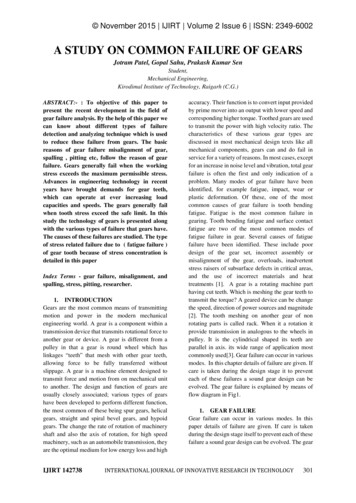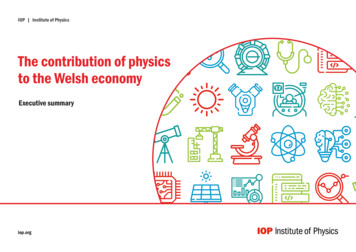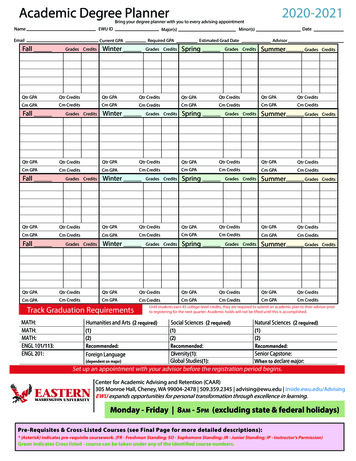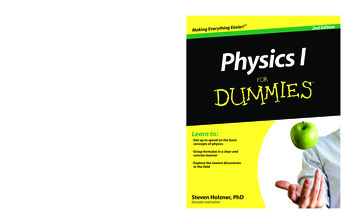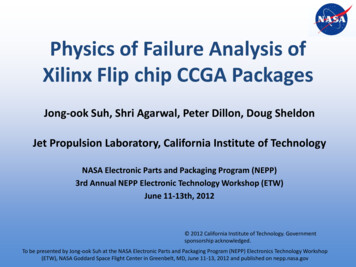
Transcription
Physics of Failure Analysis ofXilinx Flip chip CCGA PackagesJong-ook Suh, Shri Agarwal, Peter Dillon, Doug SheldonJet Propulsion Laboratory, California Institute of TechnologyNASA Electronic Parts and Packaging Program (NEPP)3rd Annual NEPP Electronic Technology Workshop (ETW)June 11-13th, 2012 2012 California Institute of Technology. Governmentsponsorship acknowledged.To be presented by Jong-ook Suh at the NASA Electronic Parts and Packaging Program (NEPP) Electronics Technology Workshop(ETW), NASA Goddard Space Flight Center in Greenbelt, MD, June 11-13, 2012 and published on nepp.nasa.gov
Outline1. Background2. Approach3. Results4. Current status of the task and future plans.5. SummaryTo be presented by Jong-ook Suh at the NASA Electronic Parts and Packaging Program (NEPP) Electronics Technology Workshop(ETW), NASA Goddard Space Flight Center in Greenbelt, MD, June 11-13, 2012 and published on nepp.nasa.gov
Background Release of Xilinx Virtex 4– Demand of more highly functional devices Iead to non-hermetic flip chipceramic column grid array packages, such as Xilinx V4. Class-Y effort– There has been on-going effort to add new a class (class-Y), in order to bring V4like packages into the QML system. Goal– Identify limit of class-Y type non-hermetic ceramic flip chip packages, beginningfrom Xilinx V4 and V5.– Check if additional reliability tests need to be done on class-Y type packages inaddition to conventional reliability tests.To be presented by Jong-ook Suh at the NASA Electronic Parts and Packaging Program (NEPP) Electronics Technology Workshop(ETW), NASA Goddard Space Flight Center in Greenbelt, MD, June 11-13, 2012 and published on nepp.nasa.gov
ApproachTwo main issues of V4/V5, class-Y type products:1. Non-hermeticity : Die and organic materials (underfill and lid adhesive) are directly exposed to spaceenvironment.ex) Underfill protects the flip chip solder joints. But nothing protects underfill from the spaceenvironment. Need to investigate how degradation of organic materials in the space environmentcan compromise reliabilities of a package.2. Fine feature size One of the biggest reason why manufactures started to produce class-Y typeproducts:- Sub-90nm devices were generating too much heat. Direct lid attachment to the die was necessaryfor thermal management. Future class-Y products are bound to have fine feature size. (Thinner metallization,fine pitch flip chip solder.) Need to investigate if conventional reliability tests regarding the fine feature size aregood enough for space applications.To be presented by Jong-ook Suh at the NASA Electronic Parts and Packaging Program (NEPP) Electronics Technology Workshop(ETW), NASA Goddard Space Flight Center in Greenbelt, MD, June 11-13, 2012 and published on nepp.nasa.gov
Approach (cont’d) Xilinx offers daisy chained XCDAISY series dummy V4 samples.– Only columns are daisy chained with each other. The XCDAISY samples only allows us to testcontinuity of columns. Flip chip solder bumps can not be tested using XCDAISY samples. Due to unavailability of adequate test vehicle, concerns from organic material degradation andinterconnection reliabilities had to be dealt separately. Two different NEPP tasks were initiated at JPL1. Physics of Failure Analysis of Xilinx Flip chip CCGA PackagesMainly focus on materials issue related to the ‘Non-hermeticity’ issue.1) Evaluation of individual organic materials used at V4 and V52) More thorough DPA3) FEA2. Aeroflex technology as class-Y demonstratorMainly focus on reliably issue from the ‘Fine feature size’1) Collaborative effort with Aeroflex.2) Use Aeroflex R&D daisy chained ceramic flip chip sample.3) Study whether conventional reliability tests are enough for space applications.To be presented by Jong-ook Suh at the NASA Electronic Parts and Packaging Program (NEPP) Electronics Technology Workshop(ETW), NASA Goddard Space Flight Center in Greenbelt, MD, June 11-13, 2012 and published on nepp.nasa.gov
Importance of underfill and lid adhesiveRole of underfill Stress reduction on flip chip solder joints The underfill redistributes the stress, preventing stress concentration atthe solder joints. Stress on solder joints is reduced in more than an orderof magnitude. The underfill changes the dominant strain from shear to axial orlongitudinal, inducing hydrostatic compressive stresses on the solder joint. During thermal cycling, failure of flip chip solder joints with an underfillgenerally occur after the underfill material becomes compromised. Protects flip chip solder joints from external environment, in terrestrialapplications. Underfill plays critical role in increasing thermal cycling life of flip chippackages.Role of lid adhesive– Efficient dissipation of heat, while maintaining good adhesionbetween die and lid.To be presented by Jong-ook Suh at the NASA Electronic Parts and Packaging Program (NEPP) Electronics Technology Workshop(ETW), NASA Goddard Space Flight Center in Greenbelt, MD, June 11-13, 2012 and published on nepp.nasa.gov
Underfill study A variety of reliability testing has been performed on the V4. (ex: Thermal cycling, shock& vibration), but there are no test results directly relating reliability and performance tothe LEO environment. Reliability of materials used in Xilinx packages under the flight mission environment wasstudied. Raw underfill and lid adhesive materials used in Xilinx packages were procured with helpof IBM Bromont. JPL is the only organization other than IBM who has those materials. Bulk underfill and lid adhesive samples were fabricated at JPL for various experiments. Daisy chained V4s were also procured. JPL began studying properties, behavior and reliabilities of the LP2 underfill material asit relates to protecting the flip chip/solder bump/substrate interface when exposed toLEO environment. Also conducted ‘Due diligence’ study on existing test data onreliabilities of virtex 4.To be presented by Jong-ook Suh at the NASA Electronic Parts and Packaging Program (NEPP) Electronics Technology Workshop(ETW), NASA Goddard Space Flight Center in Greenbelt, MD, June 11-13, 2012 and published on nepp.nasa.gov
Mechanical properties of LP2 underfill material Elastic modulus and hardnessooMeasured by nano-indentation.Elastic modulus- Need to be large enough to carry the stress from the solder bumps without exerting excessivestress on the die.Need to know to perform FEA- Measured value was 8.9 GPa.Cure ScheduleRecommended cure scheduleAlternative cure scheduleo Elastic Modulus (GPa)8.94.6Hardness (GPa)0.520.32Also investigated effect of thermal aging on elastic modulus and hardness- Values increased and reached plateau within 14 days. Changes in mechanicalproperties by additional cross-linking from thermal aging can be completed in lessthan 14 days at 125 C.Adhesive strengthooDelamination of underfill is fatal for flip chip solder joints.Investigated effect of temperature on adhesive strength.- Lap shear test results remained high enough from -55 to 125 C.All measured mechanical properties met requirements for a good underfill for both terrestrialand space applications. No degradation from exposure to hot/cold temperature or thermalaging was observed.3400504035Lap Shear StrengthAs-CuredAged 7 daysAged 14 daysAged 21 daysAged 28 days45Load (mN)302520151053200300028002600240022002000Program (NEPP)Electronics Technology Workshop-70 -50 -30 -10 10 30 50 70 90 110 130To be presented by Jong-ook Suh at the NASA Electronic Parts and Packaging(ETW), NASA Goddard Space Flight Center inGreenbelt, MD, June 11-13, 2012 and published on nepp.nasa.govDisplacement (nm)0-505001000150020002500Temperature
Thermal properties and behavior of LP2 underfill material Glass transition temperatureo Properties of a polymer material (i.e, CTE, elastic modulus, electricalimpedance) dramatically change at the glass transition temperature (Tg)o It is desirable for underfill materials to have Tg outside the operatingtemperature range of the package. (ex: higher than 125 C)o Measured with differential scanning calorimetry (DSC), thermomechanicalanalysis (TMA), and Dynamic mechanical analysis (DMA).o As long as the underfill material was cured under recommended cure condition,the measured Tg was higher than 130 C.(The junction temperature will be significantly higher than the temperature of underfill.) Coefficient of thermal expansion Thermal degradationo Measured with thermogravimetric analysis (TGA)o Onset of weight loss transition was at 373.94 CTg and CTE values were satisfactory.Dimension Changeo Measured with TMA.o Ideally, CTE of underfill material should be close to or slightly higher than theCTE of the solder. (CTE of 95Pb5Sn is 29.0 ppm/ C )o Measured CTE was 21.27 ppm/ C.α 75.46μm/(m· C)α 21.27μm/(m· C)TemperatureTo be presented by Jong-ook Suh at the NASA Electronic Parts and Packaging Program (NEPP) Electronics Technology Workshop(ETW), NASA Goddard Space Flight Center in Greenbelt, MD, June 11-13, 2012 and published on nepp.nasa.gov
Outgassing behavior of LP2 underfill material Effect of vacuum thermal cyclingo Polymer chain fragmentation from vacuum thermal cycling can generate volatilecomponents inducing further outgassing. Additional surface area resulting from cracking orcrazing of a polymer can increase outgassing rates.o An XCDAISY sample was used to simulated delamination and cracking of underfill.o There was no indication of increased outgassing by thermal cycling. Effect of radiationo Radiation can induce scissioning and generate volatile fragments, resulting in additionaloutgassing.o Bulk underfill samples were exposed to O2 plasma up to 6 hours, and analyzed with DirectAnalysis in Real Time (DART) method.o No potential contaminant created by radiation was detected. Outgassing rateo Outgassing rate was measured by Molecular Contamination Investigation Facility (MCIF) atJPL.o CVCM measures the total amount of volatile component that can eventually outgas. MCIFmeasures how fast volatile components will outgas.o The outgassing rate of the LP2 underfill was extremely low.To be presented by Jong-ook Suh at the NASA Electronic Parts and Packaging Program (NEPP) Electronics Technology Workshop(ETW), NASA Goddard Space Flight Center in Greenbelt, MD, June 11-13, 2012 and published on nepp.nasa.gov
Electrical behavior Volume resistivityo Measured with standard resistivity cell, on 75μm thick LP2 material spincoated to N type 4-inch silicon wafer.o Measured volume resistivity was 3.92 1015 ohm-cm. Possibility of arcing due to radiationo There have been questions among some members of the space community,based on their experiences with printed circuit board encapsulation, as towhether or not there is any likelihood radiation may induce arcing of theunderfill.o Dielectric materials for space applications are recommended to have aminimum conductivity, in order to minimize the risk of arcing. (resistivitybelow 1015 ohm-cm.)o Even though the resistivity of LP2 material is higher than 1015 ohm-cm, therisk of radiation charging and arcing is low, because the geometry of thepackage will prevent the LP2 underfill material from charging.- In the case of very thin materials surrounded by thick materials, the energeticelectrons or protons either are stopped by other materials before they reach thematerial or pass through it entirely.To be presented by Jong-ook Suh at the NASA Electronic Parts and Packaging Program (NEPP) Electronics Technology Workshop(ETW), NASA Goddard Space Flight Center in Greenbelt, MD, June 11-13, 2012 and published on nepp.nasa.gov
LEO environment tests on underfill and lid adhesive Most of the tests were done under atmospheric pressure.- Mechanical properties Elastic modulus and hardnesso Effect of thermal agingAdhesive strengtho Effect of temperature- Thermal properties and behavior Thermal degradationGlass transition temperatureCoefficient of thermal expansion- Outgassing behavior Effect of vacuum thermal cycling Effect of radiation Outgassing rate- Electrical behavior Volume resistivity Possibility of arcing due to radiation Reliabilities of materials in Xilinx packages under the LEO environment are being investigated. There are various constituents of the LEO environment.- Vacuum, ionizing radiation, atomic oxygen, UV radiation.- High vacuum was determined to be the most relevant and realistic issue for the class-Ytype packages.To be presented by Jong-ook Suh at the NASA Electronic Parts and Packaging Program (NEPP) Electronics Technology Workshop(ETW), NASA Goddard Space Flight Center in Greenbelt, MD, June 11-13, 2012 and published on nepp.nasa.gov
Long term vacuum thermal aging tests are being conducted on theunderfill and lid adhesive materials. Effect of long term vacuum exposure on mechanical, electrical, andthermal properties on underfill and lid adhesive are being investigated.o Elastic modulus of underfillo Adhesive strength of underfill and lid adhesiveo Thermal conductivity of lid adhesiveo Tg, CTE, storage modulus, and loss modulus of underfill Other tests involving hot and cold temperatures are also being conducted.Ex) Elastic modulus of underfill at hot and cold temperaturesTo be presented by Jong-ook Suh at the NASA Electronic Parts and Packaging Program (NEPP) Electronics Technology Workshop(ETW), NASA Goddard Space Flight Center in Greenbelt, MD, June 11-13, 2012 and published on nepp.nasa.gov
Summary JPL has been investigating reliability issues of Xilinx flip chipCCGA packages in terms of underfill and lid adhesivematerials. The LP2 underfill material did not show any critical weaknessfrom tests done under atmospheric pressure. Long term vacuum exposure experiments on underfill and lidadhesive material are being conducted.To be presented by Jong-ook Suh at the NASA Electronic Parts and Packaging Program (NEPP) Electronics Technology Workshop(ETW), NASA Goddard Space Flight Center in Greenbelt, MD, June 11-13, 2012 and published on nepp.nasa.gov
The underfill changes the dominant strain from shear to axial or longitudinal, inducing hydrostatic compressive stresses on the solder joint. During thermal cycling, failure of flip chip solder joints with an underfill generally occur after the underfill material becomes compromised. Protects flip chip solder joints from external .

